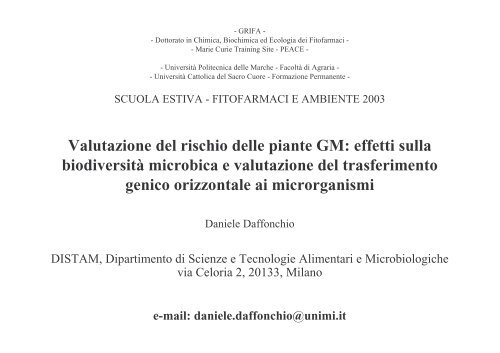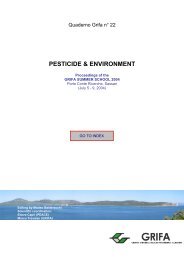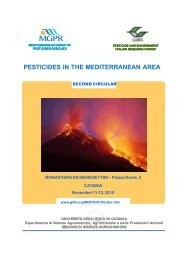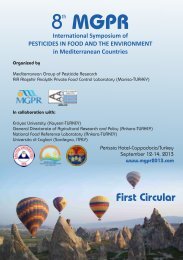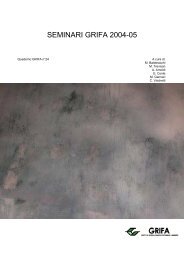D.Daffonchio - Gruppo di Ricerca Italiano Fitofarmaci e Ambiente
D.Daffonchio - Gruppo di Ricerca Italiano Fitofarmaci e Ambiente
D.Daffonchio - Gruppo di Ricerca Italiano Fitofarmaci e Ambiente
You also want an ePaper? Increase the reach of your titles
YUMPU automatically turns print PDFs into web optimized ePapers that Google loves.
•Tipologie <strong>di</strong> GMP resistenti ad erbici<strong>di</strong> ed autoprotette•Le GMP influenzano lastruttura e la funzionalità dellecomunità microbichenell’ambiente?•I transgeni possono esseretrasferiti dalle GMP aimicrorganismi nei sistemiambientali complessi?QUALI SONO I RISCHI DIIMPATTO AMBIENTALE?• Case stu<strong>di</strong>es: mais, colza, erbame<strong>di</strong>ca, patata• Considerazioni ambientali• Meto<strong>di</strong> <strong>di</strong> stu<strong>di</strong>o HGT• Case stu<strong>di</strong>es: barbabietola nptII,tabacco transplastomico aadA• Considerazioni ambientaliCONSIDERAZIONI FINALI
GMP RESISTENTI AD ERBICIDIED AUTOPROTETTE
COSTRUZIONE E TIPI DI GMPDNA donatore: Costrutto transgenico in E. coli-Transgene; -Promotore eucariota; -Terminatore eucariota; -Enhancers, ecc.;-Marcatori <strong>di</strong> selezione; -Sistemi <strong>di</strong> autoexcisione markersTessuto vegetalericeventeTrasformazione me<strong>di</strong>ante:•Agrobacterium tumefaciens•Particle gunTrasformazione me<strong>di</strong>ante:•Particle gun•Iniezioni con femtosiringheGMP “nucleari”GMP “transplastomiche”
SOIA RESISTENTE ALGLYPHOSATEConsiderata lapossibilità <strong>di</strong> HGT<strong>di</strong> geni <strong>di</strong>resistenza adantibiotici, latendenza è <strong>di</strong>eliminarli daicostrutti. Adesempio nel casodella soiaresistente alglyphosateprodotta dallaMonsanto il genenptII per laresistenza allakanamicina non èpresente nelcostrutto finale.nptIIPlasmidePV-GMGT04Transgene nella linea40-3-2 <strong>di</strong> soiaDNA soia
MAIS Bt AUTOPROTETTO CONTRO Ostrinia nubilalisIl mais Bt è autoprotetto daOstrinia nubilalis grazie alclonaggio nel suo genomadel gene cry1Ab del batterioBacillus thuringiensisB. thuringiensis subsp. thuringiensis berliner 1715SporaCristallo insetticidaMembranaRecettoreB. thuringiensis forma uncristallo parasporale proteicola tossina Cry tossica permolte specie <strong>di</strong> insetti.L’attività insetticida èprincipalmente dovuta alcristallo parasporale proteicoche si accumula fino al 25%del peso secco della cellula.
MAIS Bt AUTOPROTETTOCONTRO Ostrinia nubilalisRilevamentome<strong>di</strong>ante PCR deitransgeni del maisBt 176 autoprotettoda Ostrinianubilalis
MAIS Bt AUTOPROTETTO CONTRO Ostrinia nubilalisRagione bassa espressione:instabilità mRNA a causa <strong>di</strong>:•molti poliA e segnali <strong>di</strong> tagliomRNA.•segnali prematuri <strong>di</strong>terminazione <strong>di</strong> trascrizione.•Strutture secondarie•sequenze <strong>di</strong> splicing•i geni cry ricchi in A/T•<strong>di</strong>fferenze <strong>di</strong> ‘codon usage’Mo<strong>di</strong>fica della sequenza permutagenesi o sintesi chimica haaumentato <strong>di</strong> circa 100 volte ilivelli <strong>di</strong> espressione (250-2000ng/mg proteine).+ bla (amp)Ulteriori miglioramenti attraversoclonaggio dei geni cry nei plasti<strong>di</strong>senza significative mo<strong>di</strong>fichedella sequenza (espressione fino a50000 ng/mg <strong>di</strong> proteina).
PATATA T4La patata T4 rilascia nella rizosfera il lisozima del fago T4 e quin<strong>di</strong> migliora ilcontrollo <strong>di</strong> batteri fitopatogeni come Erwinia carotovoraCassetta NptII (Kan R )Promotore35S CaMVPeptide segnale α-amilasi <strong>di</strong> orzo:secrezione apoplastoLisozima T4TerminatoreNos 3’E’ stato messo a punto un metodoper misurare il tasso <strong>di</strong> morte deibatteri esposti alle ra<strong>di</strong>ci della patataT4Il saggio si basa sulla colorazione<strong>di</strong>fferenziale tra cellule vive e morte
PATATA T4Il numero <strong>di</strong> cellule batteriche morte sullasuperficie ra<strong>di</strong>cale della patata T4 è moltomaggiore <strong>di</strong> quello sulla Patata wild typeTale <strong>di</strong>fferenza si manifesta in tutte le fasidella crescita della piantaINDUZIONE DI RESISTENZE?
INATTIVAZIONE DEI SEGNALI DI QUORUM SENSINGMolti microrganismi attivano alcune vie metaboliche inclusi alcuni meccanismi <strong>di</strong>patogenesi solo quando sono in concentrazione elevata nel sistema e superano uncerto numero <strong>di</strong> cellule per unità <strong>di</strong> volume o superficieQuesto meccanismo denominato “Quorum sensing” è me<strong>di</strong>ato nei batteri gram- daalcune molecole segnale sintetizzate in piccole concentrazioni da ciascuna celluladella popolazione: gli acyl-homoserin lattoni (AHL)N-(3-oxohexanoyl)-L-homoserine lactoneAHLAd es. in Erwinia carotovora pv.carotovora l’espressione dellepectinasi che iniziano il processo<strong>di</strong> patogenesi è me<strong>di</strong>ato dagliAHL
INATTIVAZIONE DEI SEGNALI DI QUORUM SENSINGAlcuni microrganismicome molti Bacillusthuringiensis sono ingrado <strong>di</strong> produrreenzimi le AHLlattonasicheinattivano gli AHLpermettendo la<strong>di</strong>struzione dei segnalichimici che me<strong>di</strong>anola patogenesiTest conChromobacteriumviolaceum
INATTIVAZIONE DEI SEGNALI DI QUORUM SENSINGBiosaggio per misurare l’attività <strong>di</strong>degradazione degli AHL in E.coliricombinante clonato con un’AHL-lattonasiCeppi <strong>di</strong> Erwinia carotovora clonaticon un’AHL-lattonasi perdono lavirulenza rispetto ai ceppi wild type
INATTIVAZIONE DEI SEGNALI DI QUORUM SENSINGSono state costruite GMP(tabacco e patata) clonatecon AHL-lattonasi per essereautoprotette nei confronti <strong>di</strong>patogeni batterici.L’espressione <strong>di</strong> aiiAveniva rilevata in tutti icostrutti soprattutto inquelli con il peptidesegnale
INATTIVAZIONE DEI SEGNALI DI QUORUM SENSINGLe GMP (tabacco e patata) clonate con AHL-lattonasi sono molto resistenti adErwinia carotovora anche quando inoculata a livelli massicci.Tabacco aiiAWild TypeWild TypePatate aiiALa strategia <strong>di</strong> inibizione dei meccanismi <strong>di</strong> “Quorum sensing” dovrebbestimolare in maniera minore lo sviluppo <strong>di</strong> resistenti in quanto il patogeno non èeliminato ma solo inibito in una sua attività
•Le GMP influenzano lastruttura e la funzionalità dellecomunità microbichenell’ambiente?•I transgeni possono esseretrasferiti dalle GMP aimicrorganismi nei sistemiambientali complessi?QUALI SONO I RISCHI DIIMPATTO AMBIENTALE?• Case stu<strong>di</strong>es: mais, colza, erbame<strong>di</strong>ca, patata• Meto<strong>di</strong> <strong>di</strong> stu<strong>di</strong>o HGT• Case stu<strong>di</strong>es: barbabietola nptII,tabacco transplastomico aadA
GMP E BIODIVERSITA’MICRORGANISMI
MAIS BTTransgeni nel mais Bt:•Cry1Ab: attività insetticida•Bar: resistenza gluphosinate• bla TEM1: resistenza ampicillinaCry1Ab è espressa nei tessuti ver<strong>di</strong> fino a 4.000 ng/mg <strong>di</strong> proteineKoziel et al., 1993 Bio/Technology, 11:194-200?Cry1Ab è rilasciata negli essudati ra<strong>di</strong>cali e può persistere nel suoloSaxena et al., 1999 Nature, 402:480; Saxena and Stotzky 2000, FEMS Microbiol. Ecol. 33:35-39Il mais Bt ha un maggiore contenuto <strong>di</strong> lignina rispetto all’isogenico non BtSaxena and Stotzky 2001, Am. J. Bot. 88:1704-1706I residui <strong>di</strong> mais Bt sono meno degradabili in suoloStotzky 2003 ESF-AIGM 30
MAIS BT E DIVERSITA’ MICROBICAPHYTOSPHEREINSECT GUTENSILED MAIZE SILAGE CORNFERMENTED FLOURRHIZOSPHERECOW RUMENLa <strong>di</strong>versa composizione dei tessuti e degli essudati può influenzare lastruttura della comunità microbica?
RIZOSFERA
RIZOSFERA MAIS BT•Cariche batteriche•Profili catabolici comunità•Tipizzazione molecolare batteri isolatiSuoloParNO DIFFERENZE SIGNIFICATIVEBtPC3 = 5.6%•Analisi struttura della comunitàmicrobica totale me<strong>di</strong>anteARISAPC1 = 42.6%PC2 = 9.4%DIFFERENZE SIGNIFICATIVELa comunità batterica rizosferica del mais Bt è <strong>di</strong>versa da quella della controparte non transgenicaLe <strong>di</strong>fferenze sembrano essere in parte imputabili al pattern <strong>di</strong> essudazione
MAIS INSILATO
INSILATO MAIS BT•Cariche batteriche•Tipizzazione molecolare LAB isolatiNO DIFFERENZE SIGNIFICATIVE•ARISA ed LH-PCR evidenziano comunità batteriche <strong>di</strong>fferenti tra insilatipreparati con mais Bt e il parentale•ARISA fingerprintingBtParB7•LH-PCR fingerprintingI0I2 I7 I13I20I30B30B2 B7B13B20B20BtB0I2I30IsoPC3 = 9.0 %I13I20I7I0PC2 (34.7 %)PC3(5.3 %)B0PC1 (47.6 %)B13PC1 = 36.7 %B30B2PC2 = 14.8 %
MAIS INSILATO: LH-PCR DELLA COMUNITA’ BATTERICA250 275 300 325 350 375 400 42520001000020001000020001000020000 d2 d7 d13 dLH-PCR della comunitàbatterica totale esovrapposizione con iLABisolatiPar maisBt maisEnterobacter sp.Bacillus megateriumBacillus coagulansLactobacillus brevisW. confusa or P. aci<strong>di</strong>lacticiW. confusa or P. pentosaceusW. confusa or L. fermentumEnterococcus faecium1000020001000020001000020 d30 dL’LH-PCR mostrala successione deiLABSeguiti daEnterobacter eBacillus
RUMINE BOVINO
RISA DELLE POPOLAZIONI BATTERICHE RUMINALIAt0 At1 At2 At2 Bt0 Bt1 Bt2 Ct0 Ct1 Bt2 Ct0 Ct2 Dt0 Dt0 Dt1 Dt2•Quattro bovine <strong>di</strong> razza frisona in asciutta alimetate con maisinsilato Bt e Parentale non transgenico•Contenuto ruminale analizzato me<strong>di</strong>ante RISA
DIFFERENZE TRA LE DIETE DIETE E TRA GLI ANIMALIDIETECampionidall’animale che hasubito <strong>di</strong>slocazionedell’abomasoANIMALIABCNo <strong>di</strong>fferenze trale <strong>di</strong>eteDBtIsoDifferenze tra glianimali•L’analisi statistica dei profili RISA della microflora adesaall’alimento <strong>di</strong>gerito <strong>di</strong>fferenzia la microflora batterica nei <strong>di</strong>versianimali ma non <strong>di</strong>fferenzia le <strong>di</strong>ete
POPOLAZIONE BATTERICA IN OGNI ANIMALEMaisBtIsoL’analisi cluster dei profili RISA della microflora adesa all’alimento <strong>di</strong>gerito inciascun animale <strong>di</strong>fferenzia le popolazioni selezionate dalle due <strong>di</strong>ete
In tutti gli ambienti analizzati il mais transgenico Btseleziona popolazioni batteriche <strong>di</strong>verse rispetto allacontroparte non transgenicaRisultati simili sono stati osservati con altre GMP comecolza resistemte al glufosinate e erba me<strong>di</strong>ca che produceuna lignino perossidasi Mn-<strong>di</strong>pendente funginaDi Giovanni et al., 2000 Microb.Ecol. 37:129-139Profili DGGE rRNA 16S rizosfera COLZAProfili catabolici isolati rizosfera ERBA MEDICA
Rimane comunque da stabilire se queste <strong>di</strong>fferenze sono determinatedall’”effetto transgene” piuttosto che dall’”effetto cultivar”I fattori ambientali (cultivar, suolo,stagione, ecc.) influenzano lacomposizione della comunità battericarizosferica della patata più del lisozima delfago T4 prodotto dalle variantitransgenicheHeuer et al., 2002 AEM 68:1325-1335
HGT GMP-MICRORGANISMI
INTERAZIONI GMP E MICRORGANISMIRILEVANZA HGT•Antibiotico resistenza• Resistenza erbici<strong>di</strong>•Modello <strong>di</strong> stu<strong>di</strong>o speciazione ebarriere evolutivePRESUNTI HGT INTERDOMINIO•Es. Glutamina sintetasi II <strong>di</strong>Bra<strong>di</strong>rhizobium japonicum sembraderivare da un eucariota(Carlson e Chelm 1986. Nature 322:568-570)COME SI STUDIA?Il processo più probabile <strong>di</strong> HGT tra GMPe batteri è la trasformazione naturaleHGT tra GMP e batteri <strong>di</strong>mostrato per igeni nptII (Kan R ) e aadA (Spe R )
MARKER RESCUE TRANSFORMATION(Gebhard and Smalla, 1998; De Vries and Wackernagel, 1998; Nielsen et al., 2000)GMPTrasformazione naturale ericombinazione omologaLa ricombinazione omologa tra ungene selezionabile presente nellaGMP e una sequenza riceventeinattiva presente nel microrganismopermette <strong>di</strong> rilevare l’evento <strong>di</strong> HGTe stabilirne le frequenzeBATTERINATURALMENTECOMPETENTI•Acinetobacter naturalmente competente• npt II gene• ∆npt II
HGT da GMP“nucleari”HGT da GMP“transplastomiche”HGT da GMP“transplastomiche”in residuosfera
+COSTRUTTOBARBABIETOLAOltre ai frammentiattesi possono esseretrasferiti altresequenze <strong>di</strong> DNA(Gebhard and Smalla, 1998)=TRASFORMANTICOSTRUTTO RICEVENTE(Acinetobacter sp. BD413)
CEPPI REPORTER DI Acinetobacter sp. BD413/ADP1Progetto EUTRANSBAC QLK3-CT-2001-02242Gene Flow from Transgenic Plants: Evaluation and Biotechnology Φ# $%&# $%& Φ!!"" #"!!"" ' '((( )*+)#"
LOCALIZZAZIONE HGT IN SITU# $%&TRASFORMANTI?ANALISI IN SITUMARKER RESCUETRANSFORMATIONNlinkeraminoaci<strong>di</strong>coDOMINIOANTIBIOTICORESISTENZAAadANlinkeraminoaci<strong>di</strong>coDOMINIOANTIBIOTICORESISTENZAAadALOCALIZZAZIONEDOMINIOFLUORESCENTEGfpDOMINIOFLUORESCENTEGfpCCGage 2002 J.Bacteriol. 184:7042-7046
HGT GMP-MICRORGANISMIL’HGT GMP-MICRORGANISMIPUO’ AVVENIREMA QUALI SONO I RISCHI REALI?PROBLEMAD’INDAGINESPERIMENTALEFITNESSESELEZIONE
BIBLIOGRAFIADong et al., 2001. Quenching quorum-sensing-dependent bacterial infection by an N-acyl homoserine lactonase. Nature 411:813-817Dong et al., 2000. AiiA, an enzyme that inactivates the acylhomoserine lactone quorum-sensing signal and attenuates the virulence of Erwinia carotovora. PNAS 97:3526-3531.Lee et al., 2002. Genes Enco<strong>di</strong>ng the N-Acyl Homoserine Lactone-Degra<strong>di</strong>ng Enzyme Are Widespread in Many Subspecies of Bacillus thuringiensis. Appl. Environ. Microbiol. 68:3919-3024.Ahrenholtz et al., 2000. Increased Killing of Bacillus subtilis on the Hair Roots of Transgenic T4 Lysozyme-Producing Potatoes. Appl. Environ. Microbiol. 66:1862-1865.<strong>Daffonchio</strong> D, Cherif A and Borin S 2000 Homoduplex and heteroduplex polymorphisms of the amplified ribosomal 16S-23S internal transcribed spacers describe genetic relationships in the “Bacillus cereus group”.Appl. Environ. Microbiol. 66, 5460-5468.Di Giovanni G D, Watrud L S, Seidler R J and Widmer F 1999 Comparison of parental and transgenic alfalfa rhizosphere bacterial communities using Biolog GN metabolic fingerprinting and enterobacterial repetitiveintergenic consensus sequence-PCR (ERIC-PCR). Microb. Ecol. 37, 129-139.Dunfield K E and Germida J J 2001 Diversity of bacterial communities in the rhizosphere and root interior of field-grown genetically mo<strong>di</strong>fied Brassica napus. FEMS Microbiol. Ecol. 38, 1-9.Fisher M M and Triplett E W 1999 Automated approach for ribosomal intergenic spacer analysis of microbial <strong>di</strong>versity and its application to freshwater bacterial communities. Appl. Environ. Microbiol. 65, 4630-4636.Gyamfi S, Pfeifer U, Stierschneider M and Sessitsch A 2002 Effects of transgenic gluphosinate-tolerant oilseed rape (Brassica napus) and the associated herbicide application on eubacterial and Pseudomonascommunities in the rhizosphere. FEMS Microbiol. Ecol. 41, 181-190.Heuer H, Kroppenstedt R M, Lottmann J, Berg G and Smalla K 2002 Effects of T4 lysozyme release from transgenic potato roots on bacterial rhizosphere communities are negligible relative to natural factors. Appl.Environ. Microbiol. 68, 1325-1335.Koskella J and Stotzky G 2002 Larvicidal toxins from Bacillus thuringiensis subsp. kurstaki, morrisoni (strain tenebrionis), and israelensis have no microbicidal or microbiostatic activity against selected bacteria, fungi,and algae in vitro. Can. J. Microbiol. 48, 262-267.Lottmann J and Berg G 2001 Phenotypic and genotypic characterisation of antagonistic bacteria associated with roots of transgenic and non-transgenic potato plants. Microbiol. Res. 156, 75-82.Lottmann J, Heuer H, de Vries J, Mahn A, Düring K, Wackernagel W, Smalla K and Berg G 2000 Establishment of introduced antagonistic bacteria in the rhizosphere of transgenic potatoes and their effect on thebacterial community. FEMS Microbiol. Ecol. 33, 41-49.Lottmann J, Heuer H, Smalla K and Berg G 1999 Influence of transgenic T4-lysozyme-producing potato plants on potentially beneficial plant-associated bacteria. FEMS Microbiol. Ecol. 29, 365-377.Lukow T, Dunfield P F and Liesack W 2000 Use of the T-RFLP technique to assess spatial and temporal changes in the bacterial community structure within an agricultural soil planted with transgenic and non-transgenicpotato plants. FEMS Microbiol. Ecol. 32, 241-247.Mansouri H, Petit A, Oger P and Dessaux Y 2002 Engineered rhizosphere: the trophic bias generated by opine-producing plants is independent of the opine type, the soil origin, and the plant species. Appl. Environ.Microbiol. 68, 2562-2566.Masoero F, Moschini M, Rossi F, Gran<strong>di</strong>ni A and Pietri A 1999 Nutritive value, mycotoxin contamination and in vitro rumen fermentation of normal and genetically mo<strong>di</strong>fied corn (cry1A(B)) grown in Northern Italy.May<strong>di</strong>ca 44, 205-209.Oger P, Mansouri H and Dessaux Y 2000 Effect of crop rotation and soil cover on alteration of the soil microflora generated by the culture of transgenic plants producing opines. Mol. Ecol. 9, 881-890.Oger P, Petit A and Dessaux Y 1997 Genetically engineered plants producing opines alter their biological environment. Nature Biotech. 15, 369-372.Savka M A and Farrand S K 1997 Mo<strong>di</strong>fication of rhizobacterial populations by engineering bacterium utilisation of a novel plant-produced resource. Nature Biotech. 15, 363-368.Saxena D and Stotzki G 2001 Bt corn has a higher lignin content than non-Bt corn. Am. J. Botany 88, 1704-1706.Saxena D and Stotzky G 2000 Insecticidal toxin from Bacillus thuringiensis is released from roots of transgenic Bt corn in vitro and in situ. FEMS Microbiol. Ecol. 33, 35-39.Saxena D and Stotzky G 2001 Bacillus thuringiensis (Bt) toxin released from root exudates and biomass of Bt corn has no apparent effect on earthworms, nematodes, protozoa, bacteria, and fungi in soil. Soil Biol.Biochem. 33, 1225-1230.Saxena D, Flores S and Stotzky G 1999 Insecticidal toxin in root exudates from Bt corn. Nature 402, 480.Saxena D, Flores S and Stotzky G 2002 Bt toxin is released in root exudates from 12 transgenic corn hybrids representing three transformation events. Soil Biol. Biochem. 34, 133-137.Schmalenberger A and Tebbe C C 2002 Bacterial community composition in the rhizosphere of a transgenic, herbicide-resistant maize (Zea mays) and comparison to its non-transgenic cultivar Bosphore. FEMSMicrobiol. Ecol. 40, 29-37.Siciliano S D and Germida J J 1999 Taxonomic <strong>di</strong>versity of bacteria associated with the roots of field-grown transgenic Brassica napus cv. Quest, compared to the non-transgenic B. napus cv. Excel and B. rapa cv.Parkland. FEMS Microbiol. Ecol. 29, 263-272.Van Leeuwen W, Ruttnik T, Borst Vrenssen A W M, van der Plas L H W and van der Krol A R 2001 Characterisation of position-induced spatial and temporal regulation of transgene promoter activity in plants. J. Exp.Bot. 52, 949-959.Wieland G, Neumann R and Backhaus H 2001 Variation of microbial communities in soil, rhizosphere, and rhizoplane in response to crop species, soil type. and crop development. Appl. Environ. Microbiol. 67, 5849-5854.Windels P, Taverniers I, Depicker A, Van Bockstaele E and De Loose M 2001 Characterisation of the Roundup Ready soybean insert. Eur. Food Res. Technol. 213, 107-112.Ceccherini et al., 2003. Degradation and Transformability of DNA from Transgenic Leaves. Appl. Environ Microbiol. 69:673-678.Gebhard e Smalla 2003. Transformation of Acinetobacter sp. Strain BD413 by Transgenic Sugar Beet DNA. Appl. Environ Microbiol. 64:1550-1554.Kay et al., 2002. In Situ Transfer of Antibiotic Resistance Genes from Transgenic (Transplastomic) Tobacco Plants to Bacteria. Appl. Environ Microbiol. 68:3345-335.
RINGRAZIAMENTI• A. Rizzi, C. Bertolini, L. Brusetti, S.Borin, A. Bona, P. Francia, A.Pagliuca, M. Pajoro, M. Di Donato,D. Mora, D. Cittaro, V. Garavaglia,C. Sorlini• A. Abruzzese, G. Sacchi• A.Tamburini, G. Succi• C. Viti, L. Giovannetti• M. Bazzicalupo, E. Bion<strong>di</strong>• K. M. Nielsen• P. Simonet, A. Pontiroli• C. TebbeDISTAM, Università <strong>di</strong> MilanoDIPROVE, Università <strong>di</strong> MilanoIST. ZOOTECNIA, Università <strong>di</strong> MilanoDIBA, Università <strong>di</strong> FirenzeDBAG, Università <strong>di</strong> FirenzeDEPT. OF FARMACY, Università <strong>di</strong> TromsoUMR CNRS 5557, Università <strong>di</strong> Lione 1FAL, Braunschweig•EU TRANSBAC QLK3-CT-2001-02242 Gene Flow from Transgenic Plants: Evaluation and Biotechnology•MIUR COFIN 2000 Study of soil microbial community: effects of transgenic plants on soil microflora•MINISTERO DELL’AMBIENTE-CNR Bio<strong>di</strong>versità e organismi geneticamente mo<strong>di</strong>ficati


